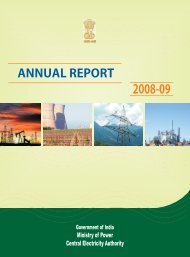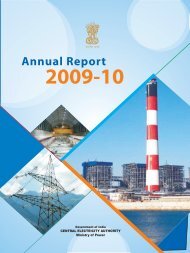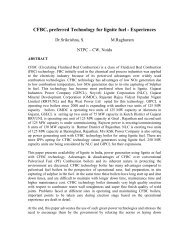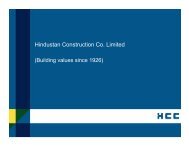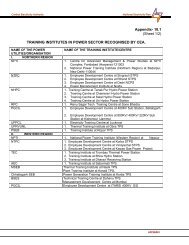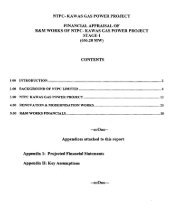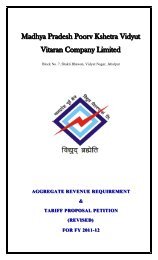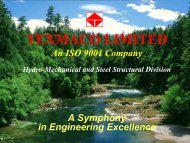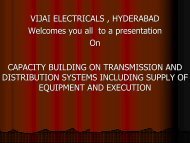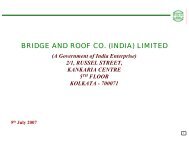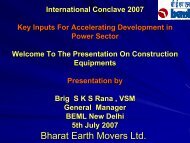O&M of Mid Sized Power Plants: The Modern Trends - By ... - Infraline
O&M of Mid Sized Power Plants: The Modern Trends - By ... - Infraline
O&M of Mid Sized Power Plants: The Modern Trends - By ... - Infraline
Create successful ePaper yourself
Turn your PDF publications into a flip-book with our unique Google optimized e-Paper software.
Operation and Maintenance<br />
<strong>of</strong> <strong>Mid</strong>size <strong>Power</strong> <strong>Plants</strong><br />
<strong>The</strong> <strong>Modern</strong> <strong>Trends</strong><br />
14th DEC2006<br />
V. B. Kabra<br />
<strong>The</strong>rmax Babcock & Wilcox- R&D
<strong>Modern</strong> <strong>Trends</strong> in Energy Systems<br />
Efficiency / Reliability<br />
Improvement<br />
Energy<br />
Systems<br />
Redesign with<br />
alternate operating inputs<br />
Renewable Energy
Efficiency / Reliability Improvement<br />
Energy Audit<br />
Efficiency/<br />
Reliability<br />
Improvement<br />
Efficiency<br />
Controls<br />
Operation &<br />
Maintenance
Energy Audit<br />
Revisit the operation and maintenance<br />
philosophy with breakdown structure<br />
• Boiler, turbine, condenser, Heating and cooling systems <strong>of</strong> plant,<br />
Electrical systems, drives, fuel handling systems etc.<br />
Compare with a world class energy efficient units<br />
<strong>of</strong> similar nature<br />
• <strong>Power</strong>, steel, refineries, heavy chemicals etc.<br />
Apply modern tools to identify the waste areas<br />
• Over design<br />
• Wrong selection<br />
• Improper operational practices<br />
Apply modern techniques <strong>of</strong> maintenance: TPM,<br />
RLA, Diagnostic
Improving efficiency <strong>of</strong> Boiler Plant<br />
Overall efficiency <strong>of</strong> GCV - Direct/Indirect<br />
Improve efficiency<br />
• Reduce stack temp. - How low ? -<br />
Sulfur corrosion/Low LMTD for ECO<br />
•Reduce Excess air<br />
•Reduce radiation loss<br />
•Reduce Unburnt carbon loss<br />
•Reduce Blow down loss<br />
•Improve efficiency <strong>of</strong> feed pumps and fans-VFD<br />
Min.Recirculation control ,Optimum Pressures<br />
•Combustion control<br />
•Changing firing system -FBC<br />
•Minimizes water & steam side depositions<br />
Fuel additives /Combustion systems/deposit monitoring system
Energy saving potential<br />
Energy saving potential in major auxiliaries<br />
Area Potential %<br />
Fans 10 - 50<br />
Feed W ater pumps 5 - 25<br />
Cooling W ater Pumps 5 – 25<br />
Cooling Tower 10 – 15<br />
Enhancing Cogeneration 20 - 25<br />
• National Benchmark : 6.5% ( Coal Fired)<br />
NTPC Western Region<br />
• International Benchmark : 3.66% ( Coal Fired)<br />
Shanghai Shidonhkou <strong>Power</strong> Plant<br />
(2 x 600MW) for year 2000
Efficiency improvement<br />
Auxiliary power consumption- Utility<br />
Coal based Stations<br />
With cooling<br />
tower<br />
Without cooling<br />
tower<br />
25 – 100 Mwe 10-11% 9-10%<br />
200 MWe series<br />
500 MW with steam<br />
driven feed pumps<br />
9.5 % 8.5 %<br />
8.0 % 7.5 %<br />
Gas and Naphtha based stations<br />
Combined cycle<br />
plants<br />
3.0%
Efficiency improvement<br />
Install VFD/ Variable Fluid Coupling for Fan with<br />
feedback control<br />
• Quantity <strong>of</strong> air delivered - 30 TPH<br />
(7.29 m 3 / sec)<br />
• Pressure developed - 510 mmWC<br />
• <strong>Power</strong> Consumption - 73 kW<br />
• Operating efficiency <strong>of</strong> fan - 55.53%<br />
• IGV control results in drop in operating efficiency<br />
Description Before After<br />
Air Flow (TPH) 32 32<br />
Pressure developed (mmWC) 520 525<br />
<strong>Power</strong> Consumption (kW) 73 58<br />
Control<br />
IGV – 46%<br />
open<br />
VFD<br />
Efficiency 55.53 % 76.28 %
Efficiency improvement<br />
Enhancing Cogeneration<br />
• Process steam requirements<br />
- Met by steam through PRDS<br />
• Any Energy Loss<br />
- Big opportunity lost if the steam flow at lower pressure<br />
is substantial
Opportunity Loss<br />
45bar, 450deg cel,<br />
797 kCal/kg<br />
Auxiliary Steam header<br />
21bar, 310 deg cel<br />
45 - 50 TPH<br />
Any throttling process - opportunity lost
Opportunity available<br />
45 bar, 450deg cel,<br />
797 kCal/kg<br />
Opportunity<br />
: 1.1 MW<br />
Auxiliary Steam header<br />
21bar, 280 deg cel<br />
708 kcal/kg<br />
Auxiliary steam- same pressure,<br />
superheated
Install steam drives for pumps<br />
Users for low temperature steam<br />
• Fuel areas<br />
• Oil burner atomizing<br />
• Gland steam<br />
• Soot blowing<br />
• Annual saving<br />
• Investment<br />
• Payback period<br />
-Rs 59.00 Lakhs<br />
-Rs. 125 Lakhs<br />
-26 months
Steam Usage<br />
Effective Condensate Removal<br />
• Inefficient condensate removal in equipments will retard heat<br />
transfer process in equipments causing<br />
(a) Drop in production time.<br />
(b) Fall on quality <strong>of</strong> output.<br />
Methods <strong>of</strong> trap monitoring tried and discarded<br />
• Spitting on trap body-most crude method<br />
• Industrial crayon colours - Color change with temp.difference<br />
• Industrial stethoscope -Bits due to velocity change<br />
• Surface temp measurement -Not very useful Unless subcooled<br />
• Ultrasonic measurement- Gaining popularity -Require Skill<br />
• Conductivity sensor -Best method but requires investment<br />
Condensate Recovery
Enhancing efficiency<br />
Deaerator<br />
• Operate at optimum temperature<br />
Feed water temperature 105 deg cel<br />
Potential to increase temperature by 10 deg cel<br />
• Additional steam consumption <strong>of</strong> 0.9 TPH<br />
Additional power generation<br />
• 117 kWh/ ton <strong>of</strong> steam<br />
Monitor furnace gas temperature<br />
Optimise soot blowing operations<br />
Optimise for Dew Point corrosion
Operator’s interface<br />
Monitoring systems will ensure<br />
energy efficiency<br />
Link to operator’s performance<br />
Shift-wise data monitoring
Controls<br />
<strong>Modern</strong> DCS monitoring system<br />
Smart intelligent efficiency monitoring systems<br />
Computational Flow Dynamics analysis for<br />
improving the flow patterns<br />
Remote performance monitoring system
Life Extension Program<br />
A well organised Life Extension Program should<br />
consist <strong>of</strong> the following phases <strong>of</strong> work<br />
1. Evaluation and Planning<br />
2. Outage- Inspection, Testings, Condition Assessment<br />
3. Post outage Testing and Studies<br />
4. Reports, Recommendations, Implementations <strong>of</strong><br />
Recommendations
Why Life Extension?
Potential causes for Premature<br />
failures<br />
Corrosion<br />
Erosion<br />
Overheating<br />
Over stressing<br />
Hydrogen Embrittlement<br />
Wrongly applied material<br />
Cycling Fatigue<br />
Corrosion Fatigue
Internal Oxide Scale in SH Tube<br />
Scale forms on the<br />
steam side <strong>of</strong><br />
superheater tubes<br />
in service.<br />
<strong>The</strong> thickness <strong>of</strong><br />
the scale formed is<br />
a function <strong>of</strong> time in<br />
service and tube<br />
metal temperature.
Inspection Techniques<br />
Replication<br />
• Mechanical Polishing<br />
• Electro polishing<br />
Hone and Glow<br />
NOTIS<br />
(Non-destructive Oxide Thickness Inspection System)<br />
FHyNES<br />
(Furnace Hydrogen damage Non-destructive Examination Service)<br />
MANTIS<br />
(Modular Automated Non-destructive Thickness Inspection System)
Nondestructive<br />
Oscilloscope<br />
Oxide<br />
Thickness<br />
Inspection<br />
System<br />
Oxide<br />
Thickness<br />
Oxide Scale<br />
Wall<br />
Thickness<br />
Special UT<br />
Transducer<br />
Tube OD
FHyNES ®<br />
Transducer<br />
Furnace Side<br />
<strong>of</strong> Tubes<br />
Hydrogen<br />
Damage<br />
Amplitude %<br />
FHyNES Scope<br />
100<br />
80<br />
60<br />
40<br />
20<br />
0<br />
2 4 6 8 10<br />
Signal from<br />
Undamaged<br />
Tube
Redesign with Alternate Operating<br />
Inputs<br />
Review cost <strong>of</strong> fuel input<br />
Review existing operating parameters<br />
Explore possibility <strong>of</strong> low cost fuels<br />
Review availability <strong>of</strong> waste fuels in the<br />
area<br />
Evaluation for conversion to multifuel<br />
firing capabilities through experts/ OEM
Steam Cost<br />
Cost comparison<br />
Boiler Fuel GCV Fuel cost Efficiency Heat input Steam cost<br />
Kcal/kg Rs/kg % MKcal/hr Rs/ton<br />
Oil/gas LDO 10200 19.00 87 32.59 1445.30<br />
FO 10000 17.00 86 32.97 1334.36<br />
LSHS 10500 16.00 87 32.59 1182.32<br />
NG 12000 9.00 85 33.35 595.62<br />
NAPHA 9500 22.00 87 32.59 1796.81<br />
TG COAL 4000 2.20 77 36.82 482.16<br />
LIGNITE 3600 1.50 75 37.80 375.02<br />
BAGASSE 2200 0.40 69 41.09 177.87<br />
RICE HUSK 3000 1.00 75 37.80 300.01<br />
FBC COAL 4000 2.20 84 33.75 441.98<br />
LIGNITE 3600 1.50 80 35.44 351.58<br />
RICE HUSK 3000 1.00 81 35.00 277.79<br />
OTHER BIOMAS 3200 0.75 80 35.44 197.76<br />
Coal+petcoke 6520 3.00 81 35.00 383.45<br />
CFB COAL 4000 2.20 87 32.59 426.74<br />
PETCOKE 8200 3.20 88 32.22 299.35<br />
Boiler : 42 TPH 45 Kg/cm2 420 deg.cel.<br />
Heat output : 28.3513 Mkcal/hr
TBW /<strong>The</strong>rmax Energy Solutions<br />
CFBC boilers - Multifuel firing/ Biomass<br />
AFBC boilers - Multifuel firing/ Biomass<br />
Grate fired - Multifuel firing/ Biomass/ Bagasse<br />
HRSGs -Fired/ Unfired/ Fresh air fired<br />
Oil & Gas fired radiant boilers/ FM boiler -<br />
FO, LDO, LSHS, Naphtha, NG, COG, BFG, LNG<br />
Low NOx Burners<br />
Renovation & <strong>Modern</strong>isations<br />
• Plant improvement projects<br />
• RLA studies<br />
• Build to Print/ Spares
TBW /<strong>The</strong>rmax Energy Solutions<br />
Waste heat Recovery systems<br />
• Process Integrated Boilers<br />
• Exhaust Gas Boilers<br />
• Waste Heat Boilers<br />
Fired Systems<br />
• Solid fuel fired<br />
• Fired Heaters<br />
• Waste fired Boilers
Petcoke Firing Technology<br />
PC FRING: Low VM restrict use, Up to 10 % blend with high<br />
VM coal. Higher percentage firing would also call for FGD<br />
system for SO2 Scrubbing.<br />
CFBC: Most suited technology, Firing up to 100% lower<br />
emissions <strong>of</strong> Sox (
TBW/B&W EXPERIENCE IN<br />
PETCOKE FIRING<br />
Results from the R&D tests were further<br />
demonstrated by commissioning 2 X 80 TPH<br />
steam generator at Shree Cement firing Petcoke<br />
70 to 80% and units are in continuos operation<br />
since DEC2003.<br />
Based on R&D Trials <strong>of</strong> co firing Petcoke with<br />
Rice Husk up to 50 %, the data is co related for<br />
design <strong>of</strong> 50 TPH unit under Installation In UP<br />
for Paper mill captive power plant<br />
Further R&D testing is proposed for Co Firing<br />
with other Biomass/ Lignite.
TBW/B&W Experience in Petcoke<br />
Firing<br />
CFBC<br />
R&D trials were carried out by B&W at Alliance<br />
research center, USA for firing 100% Petcoke in<br />
IR-CFB. Results from the test were correlated with<br />
the boiler design criteria and used to design the<br />
SIU (southern Illinois university) project in USA<br />
for firing 100% Petcoke.<br />
Thai petroleum (Thailand) CFB boiler has been<br />
burning Petcoke & coal since 1998.<br />
TBW <strong>of</strong>fering CFBC boilers for Multifuel firing<br />
upto 300 TPH
Shree Cement<br />
AFBC performance<br />
AVERAGE PARAMETERS DURING THE<br />
PERFORMANCE GURENTEE TEST<br />
Parameter Test parameters Predicted<br />
Boiler load, TPH 75.14 * 80<br />
Steam Pressure, Kg/cm2 (g) 65 65<br />
Steam temperature, °C 485* 495+/-5<br />
Coal flow, Kg/hr 2213.28 ---<br />
Petcoke flow, Kg/hr 5308.88 ---<br />
Petcoke % in fuel mixture, 70.58 70<br />
Coal % in fuel mixture 29.40 30<br />
Sorbent flow, Kg/hr 3150.00 3500<br />
SOx in flue gas,PPM 981.00 1100<br />
O2 in flue gas % 4.40 4.0<br />
Relative Humidity, % 21.00 60<br />
Gas Temp. APH out °C 140.00 140<br />
Efficiency % 83.08** 82
Renewable Energy<br />
Agriculture Based economy get edge<br />
Biomass <strong>Power</strong> generation Potential - 16000MW<br />
<strong>Power</strong> potential from Baggasse - 3500MW<br />
===============<br />
Total 19500MW
Categorization <strong>of</strong> Biomass fuels<br />
Biomass Fuels<br />
Low fouling<br />
fuels<br />
Medium fouling<br />
fuels<br />
Highly fouling<br />
fuels<br />
Baggasse<br />
Rice husk<br />
Juli flora<br />
Palm shells,<br />
Palm kernels<br />
Chili Stalk<br />
Saw dust<br />
De Oiled<br />
Bran(DOB)<br />
Shells- Coconut,<br />
Ground nut<br />
Sunflower Stalk<br />
Rice Straw<br />
Mustard<br />
Stalk.Wheat<br />
straw<br />
Cotton stalk<br />
Empty fruit<br />
Bunch (EFB)
Technologies for Biomass power<br />
generation<br />
Grate firing<br />
Combustion- Direct<br />
Firing Technologies<br />
Fluidised-bed<br />
combustion<br />
Gasification<br />
Biomass<br />
Burner<br />
Anaerobic<br />
digestion<br />
Bio-diesel<br />
Ethanol<br />
Travelling<br />
Pin hole<br />
Vibrating<br />
Conventional<br />
Hopper bottom
Biomass <strong>Power</strong> - Andhra Sugar<br />
TRAVAGRATE BOILER<br />
• Capacity- 40 tph, 42 KG Cm2g, 440 Deg C<br />
• Fuel : Bagasse and Rice Husk<br />
• Operational since 1995<br />
UNIQUE BENEFITS<br />
• Continuous automatic ash removal system avoids pressure<br />
dip while removing ash<br />
• Efficiently burns fuels like Rice Husk, Bagasse, Wood chips,<br />
C<strong>of</strong>fee husk etc.<br />
• Catenary design eliminates external chain tightening<br />
mechanism<br />
• Short section grate bars ensures low maintenance<br />
• Grate curvature ensures air sealing<br />
• Easy grate removal<br />
• Hardened Grate support for high temperature applications<br />
• Over fire air system for suspension firing for better<br />
combustion efficiency<br />
• Drum coil attemperator for better steam temperature control
Biomass <strong>Power</strong> - JOCIL<br />
OPEN HOPPER BOTTOM AFBC BOILER<br />
• Capacity - 30 tph, 66kg cm2g, 485 Deg C,r 6MW<br />
• Design - Open Hopper Bottom Design<br />
• Fuels- Rice Husk, Cotton & Chilly Stalk, Juliflora etc.<br />
• Operational since February’2001.<br />
FEATURES<br />
• Open Hopper Bottom - Babcock & Wilcox Unique Design instead<br />
<strong>of</strong> conventional bed plate design.<br />
• India’s First Multifuel biomass fired AFBC boiler designed to<br />
handle high alkali fuels.<br />
• Easy control <strong>of</strong> bed chemistry ensures high availability and<br />
continues power generation<br />
• Easy removal <strong>of</strong> agglomerates,large amount <strong>of</strong> stones and mud<br />
ensure trouble free operation round the year<br />
• Separate bunkers & feeders for storing and feeding variety <strong>of</strong><br />
fuels to meet any interruption in fuel availability.<br />
• High fuel flexibility ensures cost effectiveness in power<br />
generation.<br />
• Staggered air supply arrangement ensures complete combustion<br />
and high thermal efficiency.
IR-CFBC -<strong>The</strong><br />
modern Trend in<br />
Multifuel firing
Internal Recirculation - Circulating<br />
Fluidized Bed Boilers<br />
A simplified approach<br />
to improved flexibility<br />
and reliability<br />
Design Features<br />
• High combustion<br />
efficiency<br />
• Compact, economical<br />
design<br />
• Higher reliability and<br />
availability<br />
• Lower maintenance costs<br />
• Reduced erosion<br />
• Fuel flexibility<br />
• Low emissions
Why Build a CFB Boiler to Generate<br />
Steam and Electric <strong>Power</strong><br />
CFB is a Fuel Flexible Technology<br />
• Accepts wide range <strong>of</strong> fuels<br />
–Volatile matter - 4 - 40%<br />
–Ash - 0 - 60%<br />
–Heating value- > 1500 Kcal/kg (2700 BTU/lb)<br />
–Moisture - < 55%<br />
• Use <strong>of</strong> lower rank fuels reduces fuel costs<br />
• Fuel flexibility - minimizes fuel supply uncertainties<br />
• Ability to burn low cost and waste fuels
Internal Recirculation - Circulating<br />
Fluidized Bed Boilers
IR-CFB Boilers<br />
Furnace density pr<strong>of</strong>ile
IR-CFB Boiler Solids Flow<br />
A. Fuel and sorbent solids<br />
entering the furnace<br />
B. Upward solids flow<br />
C. Solids reflected by ro<strong>of</strong><br />
D. In-furnace U-Beam<br />
recycle<br />
E. External U-Beam recycle<br />
F. Multicyclone recycle<br />
G. Solids not captured by<br />
multicyclone<br />
H. Bed drain
IR-CFB Solids Collection Schematics
IR-CFB Boilers<br />
IR-CFB Primary Particle<br />
Collection System<br />
IR-CFB Particle<br />
Transfer Hopper
U-Beam separators<br />
1<br />
4<br />
1. Sidewall<br />
membrane panel<br />
2. U-beam - SS309H/<br />
SS310H/RA253MA<br />
3. Seal baffle<br />
4. Refractory<br />
Flue<br />
Gas<br />
&<br />
Solid<br />
Flow<br />
3<br />
Flue<br />
Gas<br />
2
U-Beams
Multicyclone Secondary Collector<br />
Individual Gas<br />
Outlet Hoods<br />
• Proven modular design<br />
• Predictable high<br />
performance<br />
• Low maintenance<br />
- Easy access<br />
- High hardness cyclone<br />
tubes<br />
- No refractory<br />
Access for<br />
Inspection<br />
High Hardness<br />
Collection<br />
Components
Kanoria Chemicals & Ind. Ltd<br />
• One CFB; installed<br />
in 1996<br />
• Sub-bituminous<br />
waste coal (45%<br />
ash)<br />
• 231,400 lb/hr (105<br />
TPH) steam flow<br />
• 938 psig (65 barg) /<br />
938°F (503°C)
Overall Grade Separation Efficiency<br />
Comparison<br />
IR-CFB Two Stage Solids Collection System vs<br />
Competitors Cyclone Based CFB System<br />
100<br />
Efficiency, %<br />
90<br />
80<br />
70<br />
60<br />
U-Beam and<br />
MDC-Based<br />
CFB<br />
Cyclone<br />
-Based<br />
CFB<br />
50<br />
40<br />
0 20 40 60 80 100 120<br />
Particle Size, Micron
<strong>The</strong> B&W IR-CFB Two-Staged Solids<br />
Separation System<br />
Benefits<br />
• High overall solid collection efficiency ~ More than<br />
99.7%<br />
• Precise furnace temperature control ~ <strong>By</strong> controlling solid<br />
recycle rate from the secondary collector<br />
• Extended turndown ratio without use <strong>of</strong> auxiliary fuel<br />
(oil/gas) ~ 100% to 20% MCR<br />
• Low auxiliary power requirements compared to<br />
competitor cyclone-based CFB technologies ~ 50-100 mm<br />
w.c.
IR-CFB Furnace Predicted<br />
Temperature Pr<strong>of</strong>iles
Kyoto Protocol<br />
Opportunities in INDIA<br />
<strong>Power</strong> Sector (51%)<br />
• IGCC <strong>Power</strong> : Potential 10,000 MW ~5Million mt CO 2 pa<br />
Transport Sector (16%)<br />
Industrial Sector<br />
• Steel (10%)<br />
• Cement (4%)<br />
• Chemicals (4%)<br />
• CO 2 Potential >5Million mt CO 2 pa<br />
Renewable Sector ( wind , solar, bagasse, minihydro)<br />
• Potential 35,000 MW: ~60 Million mt CO 2 pa
Renewable Fuel<br />
Utilisation
Fuel Characteristics<br />
Highly variable characteristics- No<br />
generalization<br />
High Volatile Matter - More combustion in free<br />
board<br />
High Moisture- Fuel Handling<br />
Less Ash<br />
High Alkaline content <strong>of</strong> ash<br />
Low Steam to Fuel weight ratio (Low Specific<br />
heat content
Firing Technologies<br />
Grate firing<br />
• Travelling<br />
• Pin hole<br />
• Vibrating<br />
Fluidised bed combustion<br />
• Conventional<br />
• Hopper bottom<br />
Burner
Technological solutions<br />
Tailor made Combustor design<br />
• TG,CCZ ,Hopper Bottom design<br />
• FEGT, ( < 810 °C )<br />
• Combustion air control system<br />
• Fuel flexibility<br />
Co- Combustion, Right mix <strong>of</strong> fuel<br />
Additives / Cleaning <strong>of</strong> heating surfaces<br />
Furnace & Convection Banks Design
Facts about Biomass as fuel<br />
<strong>The</strong> limited furnace volume and high furnace exit<br />
gas temperatures <strong>of</strong> most biomass boilers promote<br />
slagging or deposits from those bi<strong>of</strong>uels that<br />
contain significant amounts <strong>of</strong> potassium or<br />
sodium, sulfur, chlorine and silica.
Hopper bottom design<br />
Unique design <strong>of</strong> B&W (Developed for effluent<br />
/MDF firing ) which can handle the difficult ,<br />
agglomerating fuels.<br />
Allowing uniform draining <strong>of</strong> agglomerate /<br />
clinkers through hopper bottom.<br />
Ease on multiple fuel firing through over bed .
Biomass Energy
Thank You!



